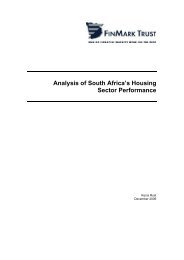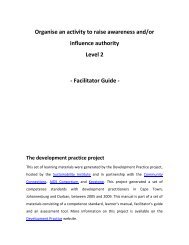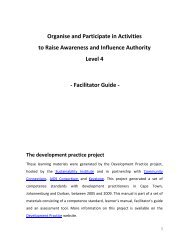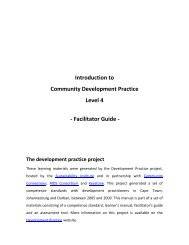the struggle for integrated sustainable settlements.
the struggle for integrated sustainable settlements.
the struggle for integrated sustainable settlements.
Create successful ePaper yourself
Turn your PDF publications into a flip-book with our unique Google optimized e-Paper software.
Adobe is a truly natural building material, and because <strong>the</strong> bricks are often made by hand on site, energy<br />
use is minimal.<br />
The Tlholego Development Project near Rustenburg in <strong>the</strong> North West Province is a <strong>sustainable</strong> ecovillage<br />
described in Building without Borders by Joseph Kennedy (2004). The building system used is locally<br />
manufactured mud-brick walls built on concrete block and stone foundations. The walls were rubbed down<br />
with water to reduce cracks and <strong>the</strong>n coated with linseed oil and turpentine <strong>for</strong> wea<strong>the</strong>r resistance. Insulated<br />
timber ceilings were installed, with corrugated iron roofs. Passive solar techniques were used like solar<br />
orientation, <strong>the</strong>rmal mass and overhangs.<br />
Stabilized earth blocks<br />
Ear<strong>the</strong>n buildings have been built <strong>for</strong> thousands of years, and <strong>the</strong>re is a strong tradition of ear<strong>the</strong>n<br />
structures on <strong>the</strong> African Continent. Traditional mud huts were <strong>the</strong> most common <strong>for</strong>m of building be<strong>for</strong>e<br />
<strong>the</strong> advent of modern architecture and planning. Earth buildings still shelter more than a third of <strong>the</strong><br />
world’s population.<br />
Recently <strong>the</strong>re has been a worldwide resurgence of interest in earth building, especially in developing<br />
countries where local earth is <strong>the</strong> most accessible source of building material. However, most soils do not<br />
contain <strong>the</strong> mix of clay, silt and sand required <strong>for</strong> good brick making.<br />
Modern stabilization technology (such as AnyWay Soil Block - a non-toxic chemical stabilizer) has broadened<br />
<strong>the</strong> range of natural soils suitable <strong>for</strong> making compressed stabilized earth blocks (CSEBs), and increased<br />
<strong>the</strong>ir strength and durability.<br />
Compressed stabilized earth blocks have <strong>the</strong> following advantages:<br />
• An earth block walling system is much cheaper than bricks. The use of local soil and on-site manufacturing<br />
saves on transport costs and fuel consumption, especially in remote areas with poor road infrastructure.<br />
• Pressed earth blocks have a low embodied energy value of around 0.42 MJ/kg and a negligible carbon<br />
foot print.<br />
• Earth structures have good <strong>the</strong>rmal properties which save on heating and cooling costs. A study by <strong>the</strong><br />
Institute of Technology, University of Fort Hare found that traditional mud huts offer better <strong>the</strong>rmal com<strong>for</strong>t<br />
than low-cost RDP houses, and ash brick houses had a better <strong>the</strong>rmal per<strong>for</strong>mance than RDP houses<br />
(Makaka, G & Meyer, E. 2006).<br />
• AnyWay stabilized block making is a non-toxic and environmentally safe process.<br />
• Earth blocks are fi re, noise and bug resistant.<br />
• It is a labour-intensive brick-making process that can be easily taught, and <strong>the</strong> stabilizer can be used in<br />
remote areas to create earth building material.<br />
page 37








